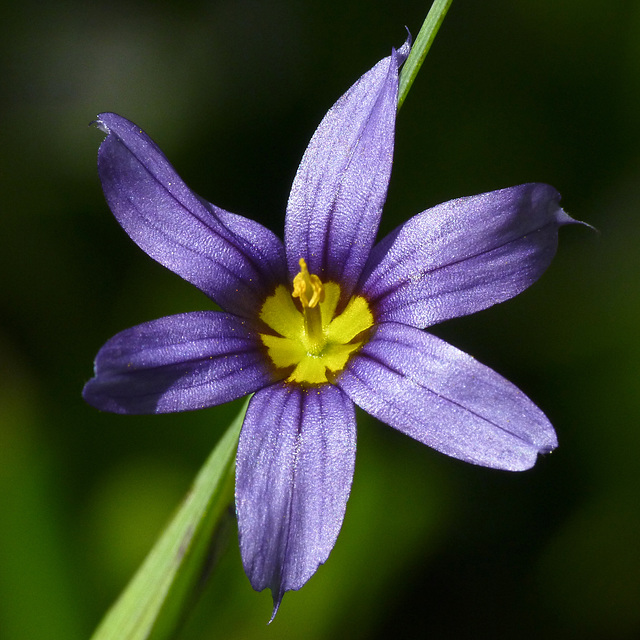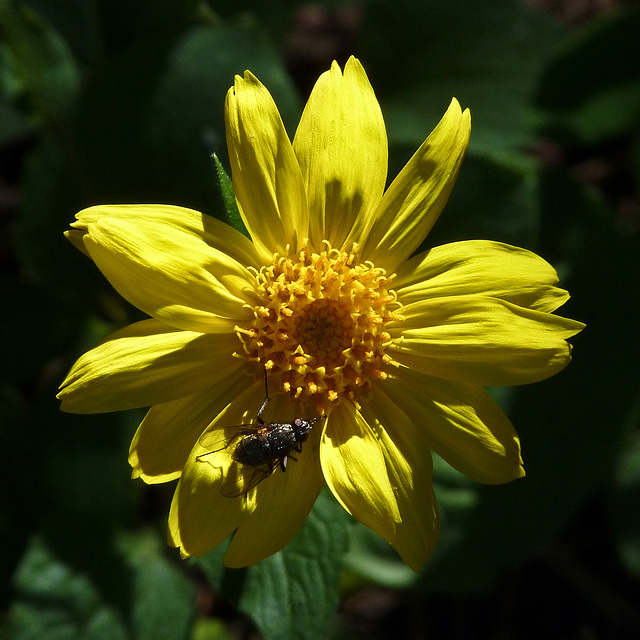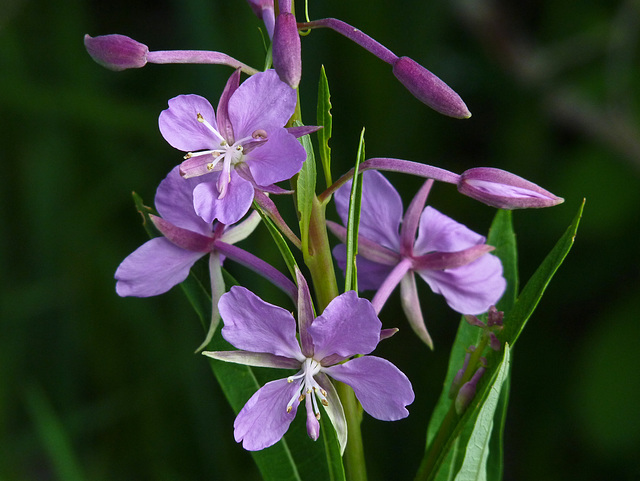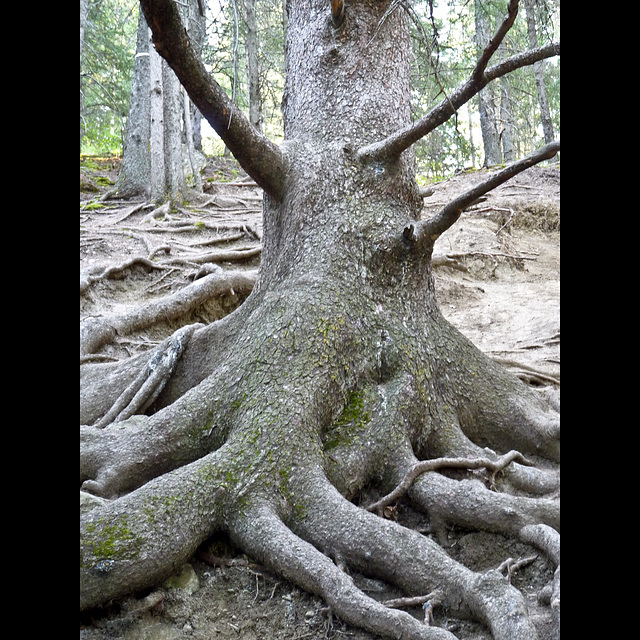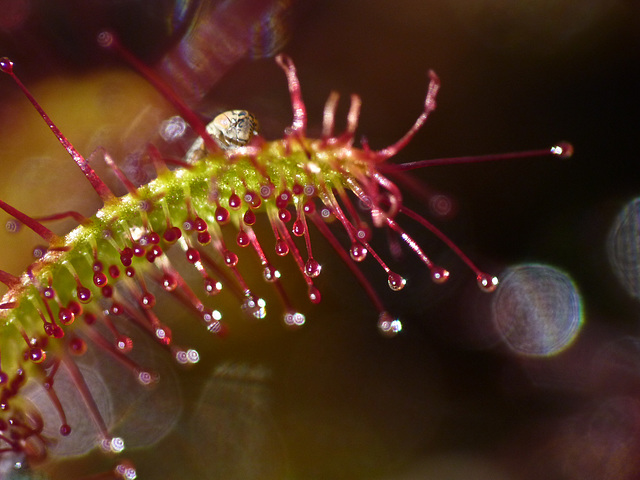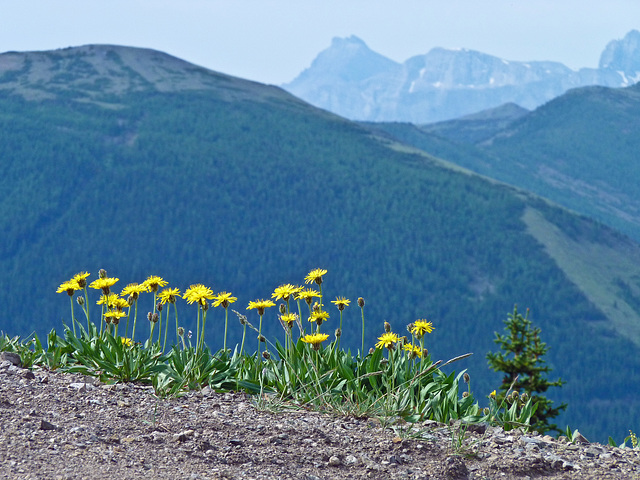
Plants of Alberta 4
Blue-eyed Grass
OK, I'm happy - I think this photo shows that it IS possible for me (I know others can do it) to take reasonable photos outdoors with the Raynox 250. I didn't bother to carry my mini, table-top tripod this time, so this image was hand-held, with a light breeze. These Blue-eyed Grass flowers are so gorgeous. The flower of the Blue-eyed Grass (Sisyrinchium montanum/Sisyrinchium angustifolium) is only about 1 cm or less than 1/2 inch in diameter, and the plant is a member of the Iris family. Photographed this one today, when I went along Elbow Fall Trails into the beginning of the eastern edge of the Rocky Mountains and called in at the Ing Mine's parking lot area. I was so disappointed today, as I overslept by almost two and a half hours and so missed a lovely day of botanizing with friends at Bow Valley Provincial Park. I had been waiting a year to get back to this particular area. It is a popular area for wildflowers, but is also a great place for birding.
talkaboutwildlife.ca/profile/?s=1063
Heart-leaved Arnica/Arnica cordifolia
Always a joy to come across some of these large, vibrant yellow Heart-leaved Arnica (Arnica cordifolia) flowers when walking in the forest. This one was growing a few days ago in the forested area at the Priddis Greens Golf Course, when we made a return visit to record all flora and fauna seen that day. This is a native wildflower that grows in the forests of the foothills and mountains. It belongs to the Aster family (Asteraceae) and blooms June-August. it's basal leaves are oblong to oval or heart-shaped, hence the common name.
Fireweed
Fireweed adds so much beautiful colour to wild places. Photographed this particular plant out in Kananaskis recently, when we botanized some forest along the edge of Barrier Lake.
"Epilobium angustifolium, commonly known as Fireweed (mainly in North America) or Rosebay Willowherb (mainly in Britain), is a perennial herbaceous plant in the willowherb family, Onagraceae. It is native throughout the temperate Northern Hemisphere, including large parts of the boreal forests.... It has a tendency to quickly colonize open areas with little competition, such as sites of forest fires and forest clearings." From Wikipedia.
en.wikipedia.org/wiki/Epilobium_angustifolium
29 Jul 2010
Timothy grass
This is Timothy grass (Phleum pratense) in bloom. It turns a beautiful purple colour and is quite attractive.
en.wikipedia.org/wiki/Timothy-grass
Monster of the woods
This amazing tree is growing in the woods near the Cochrane Ranche, an historic site, north west of Calgary. The Cochrane Ranche was Alberta's first large scale livestock operation. Seen on 25th July, when we explored the trails on our way to spend the day botanizing Angela Cumberland and Patrick Brennan's beautiful ranchlands.
27 Jul 2010
Menzies' Catchfly
A couple of us noticed several of these very small, white flowers growing at the base of a tree in Bragg Creek Provincial Park a couple of days ago. A casual glance in their direction brought Mouse-eared Chickweed to mind, but somehow, that just didn't feel right. After all the rain and hail we've had recently, it almost looked like the petals may have been damaged. However, we were told that this plant was Menzies' Catchfly (Silene menziesii) - a plant that I had never seen or even heard of before.
Sorry the image is blurry - took this using my macro lens and I'm stilll in the process of learning how to use it outdoors. At least you can tell the interesting shape of the petals. The fact that I've just woken up after falling asleep in front of the TV again, straight after having supper, doesn't help anything look sharp, LOL.
Four of us had such an enjoyable day today, botanizing the 160 acres of rolling grassland and forest belonging to J. Edworthy, down south of the city, past Black Diamond. One of the prettiest areas you could imagine - so many colourful wildflowers in the grassland, and all sorts of moths and butterflies, and even a few fungi. Was thrilled to bits to see a Police Car Moth - and can you believe it, I realized afterwards that I hadn't turned Conversion off in my camera when I removed my macro lens - ahhh!! Not sure if I'll be able to sharpen a photo enough to post. Thanks so much, Christine, for showing us this beautiful area!
www.efloras.org/florataxon.aspx?flora_id=1&taxon_id=2...
Sundew magic
It was fun to see very small Sundew plants yesterday, growing in Cremona/Elkton bog, north west of the city. You have to get partially submerged to get photos of this fascinating, carnivorous plant, LOL! Not exactly easy to get a good photo, I find, but this one came out OK. Does that look like a tiny bug up in the top, left quarter of the image? (Taken with my mcaro lens, so very much enlarged). In reality, it is very tiny.
"The carnivorous sundew plant, botanical name Drosera, has about 130 species. All of the species of the sundew plant are beautiful and many look like fireworks, but they are deadly to the insects that fly near to them. One thing that all carnivorous sundew plants do have is the gel-like substance at the tips of the tentacles that cover the leaves. This gel is a sticky substance that the insects that fly too near the plant get stuck on. The plant can then eat it. The many species of the sundew plant can be found all around the world, on every single continent. This is unusual for a plant because most carnivorous plants are found only in one or two regions of the world because of the different climates that they must live in. The plant is called sundew because of the gel like substance on the tentacles. The gel makes the plants look as if they have morning dew on them all day long, especially when it glistens in the sun." From www.carnivorous--plants.com/sundew-plant.html
Climbing to Plateau Mountain
The main reason I took this shot was because there was a ditch across the path where I could stand and take it. I knew I was in for a lot of kneeling and getting down and up again the further we went, so avoided kneeling on the gravel at some inelegant angle this time. These are "just" False Dandelions, but they were growing right where I wanted : ) This was a wonderful hike, even though we didn't go up on to the flat top of the Plateau (way off to the left of the photo). The grassy hillsides were covered in wildflowers, several new ones, too. It is a very long drive from Calgary, though. The rain waited until we were ready to go home and, thankfully, it wasn't a really hot day. Thanks, Moya, for taking us to explore this great place! And thanks to Robin's husband for driving us there and back!
www.albertaparks.ca/media/2741526/plateau_mtn_mgmt_plan.pdf
Rocky Mountain Sandwort / Minuartia austromontana
Another new wild plant for us, found while botanizing Plateau Mountain a couple of days ago. Up till about an hour ago, this plant remained unidentified. I then received an e-mail giving an ID : ) We are pretty sure it has to be Minuartia austromontana. Also known as Columbian stitchwort. This is such a tiny plant with teeny flowers that an average person would never notice on a walk. Seen through a macro lens, though, their hidden beauty is revealed!
www.efloras.org/florataxon.aspx?flora_id=1&taxon_id=2...
Jump to top
RSS feed- Latest items - Subscribe to the latest items added to this album
- ipernity © 2007-2024
- Help & Contact
|
Club news
|
About ipernity
|
History |
ipernity Club & Prices |
Guide of good conduct
Donate | Group guidelines | Privacy policy | Terms of use | Statutes | In memoria -
Facebook
Twitter

